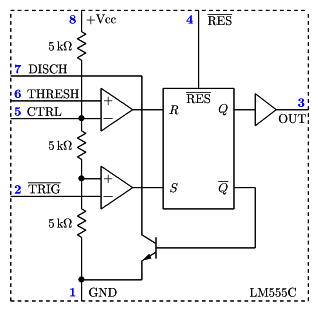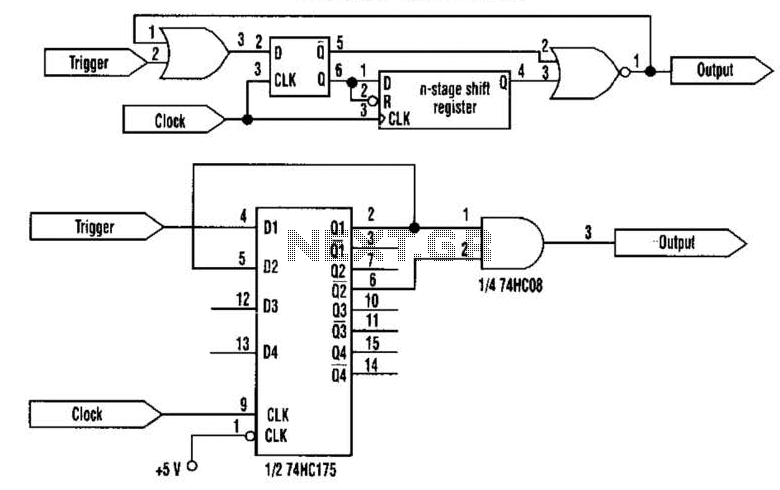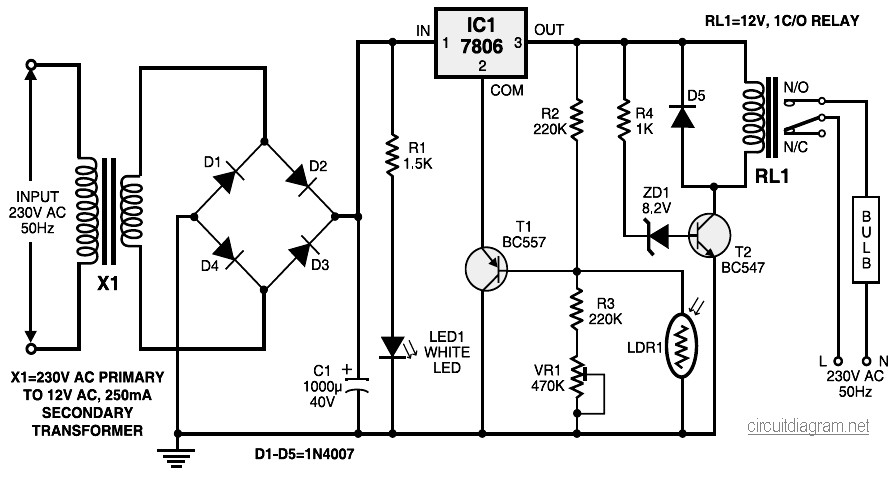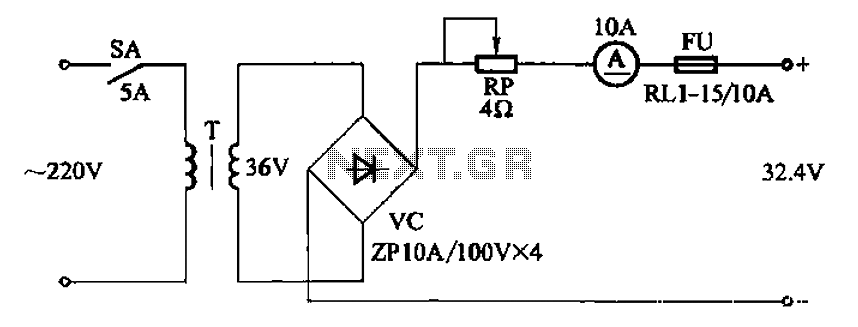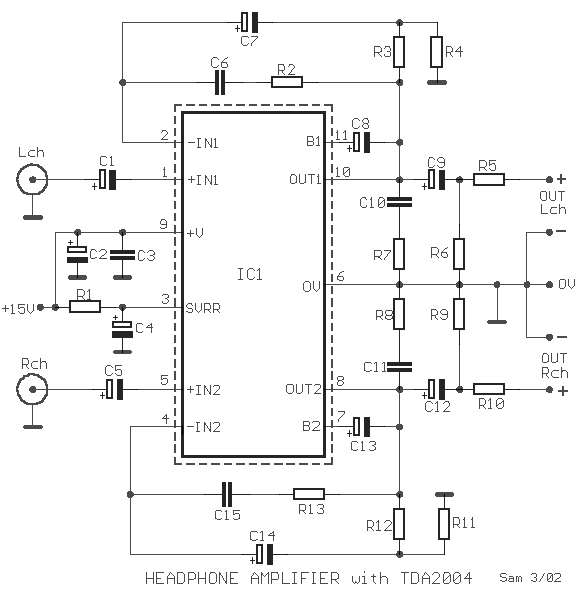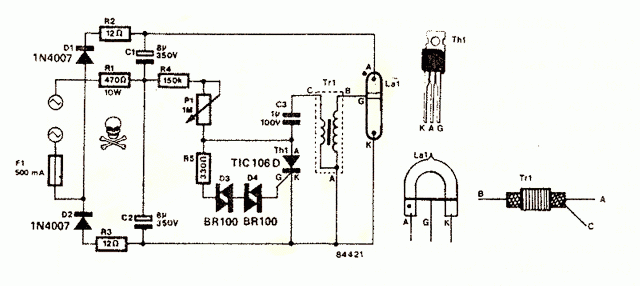
Car Voltmeter Circuit
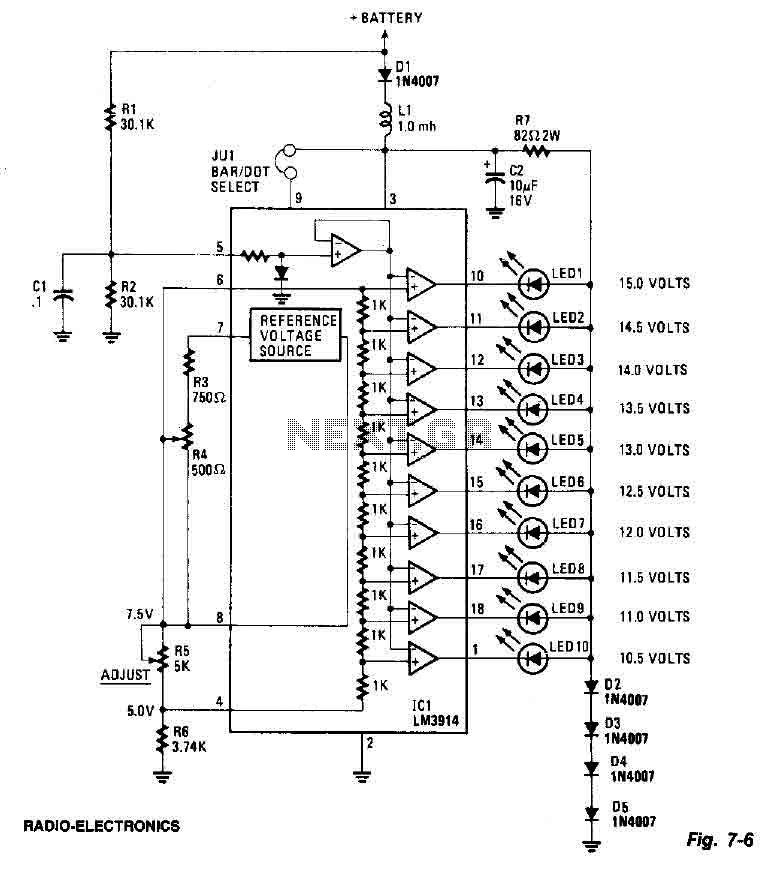
This screen utilizes ten LEDs to indicate a voltage range from 10.5 to 15 volts, with each LED corresponding to a 0.5-volt increment. The core component of the circuit is the LM3914 LED bar graph/display driver. A trimming potentiometer, R5, is calibrated to ensure that 7.5 volts is supplied to the upper side of the bulkhead. Resistor R7 and diode D5 are configured to regulate the voltage supplied to the LEDs to 3 volts. Additionally, a low-pass filter composed of inductor L1 and capacitor C2 is implemented to mitigate voltage spikes. The circuit also incorporates diode D1, which serves as protection against reverse voltage when the voltmeter is connected in reverse.
The circuit design features a series of ten LEDs arranged to provide a visual representation of the measured voltage level. Each LED illuminates sequentially for each 0.5-volt increment, allowing for an intuitive display of the voltage range. The LM3914 driver is specifically chosen for its ability to drive multiple LEDs in a linear fashion, ensuring accurate representation of voltage levels.
The trimming potentiometer R5 is an essential component, as it allows for calibration of the circuit. By adjusting R5, the voltage reference point can be set to 7.5 volts, which is critical for ensuring that the display accurately reflects the input voltage range. This adjustment helps maintain the linearity of the LED display.
Resistor R7, in conjunction with diode D5, plays a crucial role in regulating the voltage supplied to the LEDs. By ensuring that the voltage does not exceed 3 volts, this configuration protects the LEDs from potential damage due to overvoltage conditions. The use of a low-pass filter, consisting of inductor L1 and capacitor C2, is implemented to smooth out any voltage spikes that may occur in the circuit, thereby enhancing the reliability of the voltage readings displayed.
Furthermore, diode D1 is included in the design as a protective measure against reverse polarity connections. This diode ensures that if the voltmeter is connected in reverse, it will prevent damage to the circuit by blocking any reverse voltage from affecting sensitive components.
Overall, this circuit provides a robust solution for visual voltage monitoring, utilizing a well-thought-out arrangement of components to ensure accuracy, safety, and durability in operation.This screen uses ten LEDs to display a voltage range of 10.5 to 15 volts. Each LED represents a step 0.5wvolt tension. The heart of the circuit is the 3914 points LM / bar display driver. Trimming potentiometer R5 is adjusted so that 7.5 volts is applied to the upper side of the bulkhead. D2 resistor R7 and diode D5 to tighten the voltage applied to the LED 3 volts. A lowpass filter consisting of L1 and C2 guards against voltage spikes. The diode D1 is used to protect against reverse voltage where the voltmeter is connected backwards. 🔗 External reference
The circuit design features a series of ten LEDs arranged to provide a visual representation of the measured voltage level. Each LED illuminates sequentially for each 0.5-volt increment, allowing for an intuitive display of the voltage range. The LM3914 driver is specifically chosen for its ability to drive multiple LEDs in a linear fashion, ensuring accurate representation of voltage levels.
The trimming potentiometer R5 is an essential component, as it allows for calibration of the circuit. By adjusting R5, the voltage reference point can be set to 7.5 volts, which is critical for ensuring that the display accurately reflects the input voltage range. This adjustment helps maintain the linearity of the LED display.
Resistor R7, in conjunction with diode D5, plays a crucial role in regulating the voltage supplied to the LEDs. By ensuring that the voltage does not exceed 3 volts, this configuration protects the LEDs from potential damage due to overvoltage conditions. The use of a low-pass filter, consisting of inductor L1 and capacitor C2, is implemented to smooth out any voltage spikes that may occur in the circuit, thereby enhancing the reliability of the voltage readings displayed.
Furthermore, diode D1 is included in the design as a protective measure against reverse polarity connections. This diode ensures that if the voltmeter is connected in reverse, it will prevent damage to the circuit by blocking any reverse voltage from affecting sensitive components.
Overall, this circuit provides a robust solution for visual voltage monitoring, utilizing a well-thought-out arrangement of components to ensure accuracy, safety, and durability in operation.This screen uses ten LEDs to display a voltage range of 10.5 to 15 volts. Each LED represents a step 0.5wvolt tension. The heart of the circuit is the 3914 points LM / bar display driver. Trimming potentiometer R5 is adjusted so that 7.5 volts is applied to the upper side of the bulkhead. D2 resistor R7 and diode D5 to tighten the voltage applied to the LED 3 volts. A lowpass filter consisting of L1 and C2 guards against voltage spikes. The diode D1 is used to protect against reverse voltage where the voltmeter is connected backwards. 🔗 External reference
